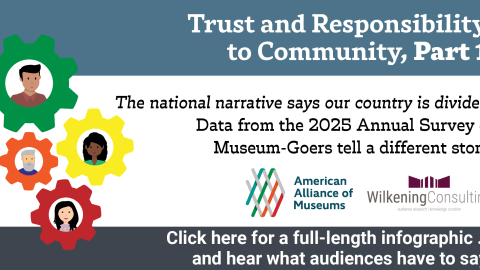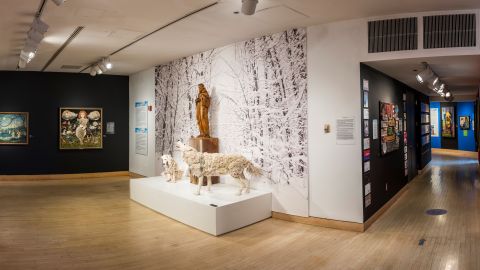One theme featured in TrendsWatch 2012 is “Takin’ It to the Streets”—the rise of pop-up and mobile retail, cultural and social experiences. Throughout the year we will monitor how this trend is playing out in museums. Today’s guest post, by Allison Weiss, former executive director of the Southern Oregon Historical Society, relates how one museum “took it to the streets” as a creative response to an identity crisis.
When a financial crisis drove the decision to permanently close the Southern Oregon Historical Society’s general history museum, the board and staff were faced with a philosophical question: Does a museum need four walls? If our mission, which could be boiled down to “preservation and education,” remained unchanged, how could we continue to fulfill our mission without a physical building and permanent exhibits?
The answer was History: Made By You, a community-centric traveling exhibit program. Meeting the community on their own turf, we host forums at which we lead discussions on issues of contemporary importance, crowdsource an exhibit topic, and then recruit volunteers to curate the exhibit hand-in-hand with our professional staff.
As we planned on replicating this project throughout the county, we needed a system for building and installing exhibits that was extremely flexible and could be used in a variety of spaces. The intent was not to build an exhibit, rotate it among several locations and then put it into retirement. We envisioned a system in which we could reuse the main components over and over, and configure the set up to fit typical and atypical spaces – a bank lobby, a business foyer, the mall, a school hallway.
The exhibits also needed to be secure and look professional. Dissatisfied with existing trophy cases and cumbersome vitrines, we hired an industrial designer who created unique modular units that became the foundation for History: Made By You.
To understand how the modular units work, imagine a pie. Now imagine that same pie but make it six feet tall, nine feet in diameter, and cut into eight equal pieces. Because we had no preconceived idea as to how large our exhibits would be, and did not want to limit the size of the space in which we could do installations, we designed the units so they could be used as a single section (or “pie slice”) or up to as many as eight sections (the “full pie”). The sections can stand alone, be joined, placed side by side or fill a corner – it all depends on what spaces are available.
[Notice how two sections can be configured into one larger display unit. Each section has three sides, with either three glass walls or an opaque wall. When joined to another section, one wall is removed, doubling the interior space. The component parts are interchangeable, making the sections relatively inexpensive to manufacture and, should pieces become damaged, one needs only to replace a piece rather than an entire case. When disassembled all of the pieces fit inside of a van.]
It was not simply a leap of faith for us to believe that community volunteers would be interested in becoming ad hoc curators—we came to this conclusion after receiving extensive, specific feedback from our members and from people who wanted to be involved with the historical society but were frustrated by the lack of meaningful ways to be engaged as volunteers. One request we heard repeatedly was that community members wanted direct access to our collection. Direct access to our collection? Did that mean we would allow volunteers to handle artifacts? Did it mean that we would need to give up some historical authority and allow voices other than the paid curator’s to be heard? Did it mean that people other than staff would decide what topics were exhibit-worthy?
Yes! As its name suggests, History: Made By You was deliberately designed to exemplify that history is of the people, by the people and for the people. While our mission of preservation and education remains unchanged, we offer an alternative to the existing model of a historical society. Rather than staff doing all of the preserving and educating, the historical society has become a vehicle through which community members actively participate in preserving local history and sharing those stories with one another.
By their very nature, these community-driven activities do not need to take place inside of a traditional museum. By giving people the skills to preserve and disseminate history, and by taking exhibits outside of our building, we have greatly increased our impact. The number of people who participate in and then view the products of History: Made By You is far greater than the number of people who visited the museum when it was open. By removing the four walls of the museum, we “opened the doors” to the Southern Oregon Historical Society.









Thanks for sharing this great story of an organization successfully reinventing itself. This takes a lot of courage but it looks like your decisions were guided by your mission and based on audience research. Hope it inspires others to take the plunge!
Som true, Max! Very impressive.
Great to see the flexibility in the display and to hear how the community want to use it to tell their stories. Could you possibly share some of the exhibits they have developed? and let us know how the co-curation is working?
many thanks
ngā mihi nui
Kristelle
Hi Kristelle, thanks for your comment!
I'm the program director for History: Made by You. We've completed two traveling exhibits, and we're wrapping up the third this week!
For the first project, SOHS worked with residents of Central Point. We explored how their historic buildings symbolized their agricultural heritage to produce "Icons of Agriculture: Central Point's Community Roots." SOHS worked extensively with volunteers and the Rogue Valley Creamery to research, produce, and move the exhibit.
The second project focused on Lake Creek, a rural village, to investigate how their community brought new technology (electricity, the telephone) to their area. Volunteers from the Lake Creek Historical Society helped me make connections within their community, and I guided them through taking oral histories and developing the label text and stories. Photos of "Wire by Wire: How the Telephone, Fencing, and Electricity Came to Lake Creek" are available on our website: http://www.sohs.org/resources/events/history-made-by-you/lake-creek
The current History: Made by You project is working with the local bicycling community. I partnered with the Southern Oregon University Bike Program, run by students, and together we've developed an exhibit exploring how bicycling has shaped southern Oregon, with a focus on transportation, freedom, and lifestyle. "Pedaling History: The Roll of Bicycling in Jackson County" opens May 24 at the SOU Student Union.
The co-curration is extremely successful. Each community has taken ownership of their exhibit, and volunteers actively seek out other community members to involve in the project.
Hope this answered your question!